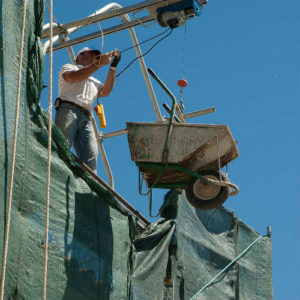This article is brought to you by the scaffold accident lawyers at Banville Law.
Nearly anywhere you travel in New York if you see construction being performed on a building you will likely see scaffolding. The use of scaffolding makes sense - it allows construction workers to continue whatever job they are doing without having to constantly go up and down a ladder to move. It also allows those same employees to keep the tools that they need with them. The problem is that if scaffolding isn’t properly constructed, it collapses, sending workers and their supplies down to the earth.
All it took were a few seconds for the life of a 37-year-old man to change forever.

He was lucky to have survived the fall, however, he fractured his pelvis and one elbow and ultimately developed an ileus, which is a painful blockage of the intestine. He had to undergo surgery for all three injuries. His medical bills nearly reached $100,000 and to make matters worse, his employer did not have workers’ compensation coverage.
Not only was he in serious physical pain and suddenly unable to work, but he didn’t even have workers’ comp to pay for his medical bills, leaving him in serious debt. This is why he chose to file a lawsuit against his employer. In his complaint, he alleged that his employer had failed to secure the scaffolding resulting in his accident and subsequent injuries.
The case went to trial and while the jury deliberated, the plaintiff and the defendant agreed to a high-low agreement. The agreement ranged from $2.5 million to $5 million. Ultimately, the jury awarded the plaintiff with $6.25 million.
When a high-low agreement is in place, it guarantees the plaintiff certain amounts of money but also protects the defendant. It is essentially a form of settlement in which the plaintiff is given a minimum amount if they also agree to accept the maximum amount in the agreement - even if the judge or jury awards them more.
So in this case, although the jury awarded more than $6 million, the plaintiff received $5 million because it was the maximum amount allowed per the terms of their agreement.
No, actually in most cases, employees are prevented from suing their employers because a workers’ compensation insurance policy is in place. When an employer offers workers comp - and most are required to have coverage by law - their employees are provided with coverage for their medical expenses for any injuries that occur during their course of work. In most cases, it doesn’t matter how the accident happened because the insurance is “no-fault” meaning employees own actions could have contributed to the accident and they will still be covered. In return for this coverage, employees are prevented from filing a lawsuit against their employer.
This doesn’t mean, however, that a lawsuit can’t be filed. In many construction accident cases, a third party has been negligent and the injured worker can pursue legal action against them as a result.

Sometimes the negligence isn’t obvious which is why it’s always important to have an attorney review your accident after being hurt on the job. Even if your medical bills are covered by workers comp, a lawsuit can ensure that future losses such as lost wages, physical pain and suffering, and emotional trauma are fully covered.
In order to determine how much a case could potentially be worth, an experienced construction accident attorney would need to review the facts and calculate the losses that have been sustained by the client. No two cases are the same, so therefore no two outcomes will be the same.
See our next article: https://banvillelaw.com/scaffolding-traps-five-people/